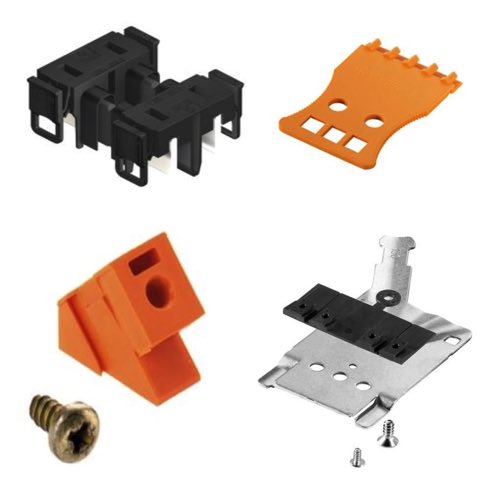Connector Accessories

RSP Supply offers a comprehensive selection of connector accessories designed to improve the functionality, reliability, and longevity of electrical connector systems. These accessories support proper cable termination, secure connections, and environmental protection across a wide range of industrial and commercial applications. Available options include crimp contacts, clip-in feet, coding elements, strain relief components, and other connector-related hardware.
Strain relief accessories help reduce mechanical stress at the cable-to-connector interface by limiting excessive bending and pull forces. By distributing stress away from termination points, strain reliefs significantly extend cable life and help prevent conductor damage, particularly in handheld devices or applications subject to frequent movement. Cable glands and grommets provide additional protection by sealing and securing cables as they enter connectors or enclosures.
Protective accessories such as boot covers further enhance connector performance by shielding connections from moisture, dust, dirt, and accidental contact. Connector accessories from manufacturers such as Phoenix Contact and Weidmüller support organized, durable, and secure electrical installations.
FAQs
Q: What are connector accessories used for?
Connector accessories are used to enhance connector performance by providing strain relief, secure cable entry, environmental sealing, and proper alignment or coding.
Q: Why is strain relief important for connectors?
Strain relief reduces mechanical stress on cables and terminations, helping prevent conductor damage caused by bending, pulling, or vibration.
Q: What is the purpose of cable glands and grommets?
Cable glands and grommets secure and seal cables as they enter connectors or enclosures, protecting against moisture, dust, and dirt.
Q: What materials are connector boot covers made from?
Boot covers are typically made from rubber, plastic, or similar flexible materials designed to protect connectors from environmental exposure and physical damage.
Q: Which manufacturers supply connector accessories?
RSP Supply carries connector accessories from established manufacturers including Phoenix Contact and Weidmüller.
Why Buy Connector Accessories from RSP Supply
RSP Supply provides a reliable selection of connector accessories designed to support secure, organized, and long-lasting electrical connections. Our offerings from trusted manufacturers help protect connectors and cables from mechanical stress and environmental exposure. Customers rely on RSP Supply for accurate product information and accessories engineered to perform in demanding electrical and industrial applications.

